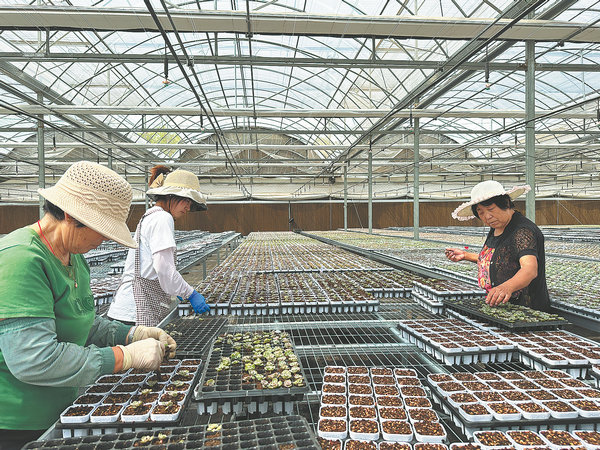

R&D equals blooming biz
"There are limited areas to grow flowers, so we are developing technologies to cultivate new varieties to enter more markets and increase the added value of flowers," said Zheng.
During the past few years, the Qingzhou government has been supporting companies in seedling research and development.
The support has seen the annual production of flower seedlings in the city exceed 70 million.
As one of the earliest companies to engage in the business of butterfly orchids in Qingzhou, Lyusheng has developed a seedling bank that has a total of over 300 butterfly orchid varieties, among which more than 200 are new varieties the company developed itself.
But 27 years ago, the company only traded in bloomed butterfly orchids.
These butterfly orchids that cater to people's different tastes are bringing more customers to the company, generating an average annual sales growth of 20 percent over the past three years.
"Technology determines whether an enterprise can develop better," said Wang, the company's chairman.
In 1996, Wang began to buy butterfly orchids from southern cities and sold the flowers in Qingzhou. Two years later, Wang realized that seedlings are much cheaper than bloomed flowers. In 1998, Wang bought thousands of seedlings and attempted to cultivate them into blooming flowers.
"At that time, I couldn't find anyone in Qingzhou to learn how to grow a butterfly orchid because few people in the county grew butterfly orchids, a kind of flower typically grown in South China," said Wang.
The first batch of seedlings Wang bought died because they weren't used to the soil and climate in Qingzhou.
"I spent several years trying more than 10 types of soil and finally found the proper soil for butterfly orchids," said Wang.
To master the climate needed for orchid growth, Wang went into the greenhouse every two hours to test the temperature and recorded it in his notebooks.
After several years, Wang mastered the growth habits of butterfly orchids, such as the number of days each growing stage takes and the temperature of each stage.
"Taiwan's technology for raising butterfly orchids is the best. Now our company's technology is at the same level as Taiwan's," said Wang.
Companies in Qingzhou have built long-term cooperation with universities and research organizations including Beijing Forestry University and South China Agricultural University, to enhance research and development abilities.
Expanding markets
At a succulent plant base run by Liu Qiang, three young women promoted succulent plants on a live-streaming platform in early June. Surrounding them were potted succulents of different colors and shapes lined up one by one.
In less than one minute, more than 30 succulent plants were sold.
Liu's base sells around 4 million succulents each year, among which 30 to 40 percent are sold through e-commerce platforms.
Qingzhou has more than 500 enterprises and farmers running succulent businesses, producing over 1 billion succulents every year, making the county the biggest succulent-growing base in China, according to statistics from the county government.